 One of the biggest factors to the success of your website’s conversion rate is building trust with your visitors, and certainly one of the best ways to build that trust is through Social Proof. A key component of Social Proof for many businesses is their customer testimonials.
One of the biggest factors to the success of your website’s conversion rate is building trust with your visitors, and certainly one of the best ways to build that trust is through Social Proof. A key component of Social Proof for many businesses is their customer testimonials.
Most pure ecommerce sites have Product Reviews set up for everything they sell, but for many other businesses, customer testimonials are the closest thing they have to product reviews by purchasers. And the importance of good quality testimonials cannot be overstated. Digital Marketing guru Neil Patel sums it up nicely, saying they “establish credibility.”
“Testimonials give you the opportunity to prove claims about your product or service. The end result is that they can help you convert more of your visitors into customers if they are used correctly.”
Testimonials are of even greater importance for small and medium size companies in niche B2B industries, or local service companies such as plumbers, body shops, etc. These firms often don’t have the big brand recognition or the PR budget to communicate their success in other credible ways. So echoing the voices of satisfied clients is essential and powerful.
The State of Customer Testimonials Today
Given their importance, it’s no surprise that most websites today do include client testimonials where relevant. However, what does surprise me is that while websites have definitely evolved over the past 20 years, for some reason far too many sites’ customer testimonials still look like they did back in 2002. Like this from a water purification systems company:
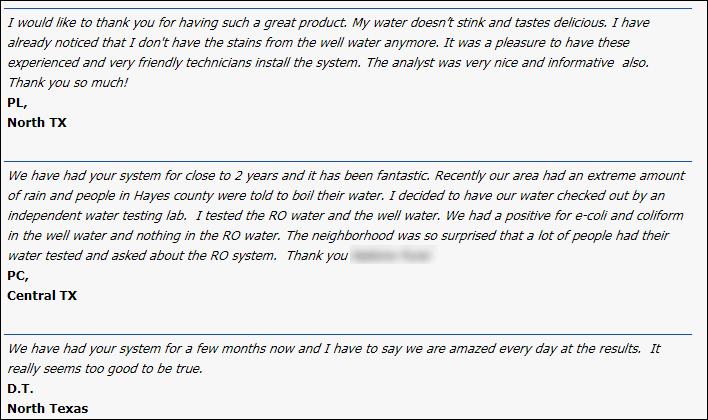
Testimonials on some websites still look like they did in the 90s, with only cryptic initials and vague locations given for the alleged customer, and burying them on a separate page where people may not see them at all.
You remember those days don’t you? Sites were afraid to divulge their customers’ actual names, so they’d do things like use initials instead of names, and use generalities like geographic areas or industries instead of actual business names of the customer. It was as if they wanted you to think they made up the testimonials themselves (which many companies were actually doing!). Forget about building trust, this was doing the opposite.
Here’s another example from a Dallas-based janitorial company (name kindly removed). Again, just a first name and last initial for the customer and nothing else. Is this person real? Does she work at an actual company and hire this janitorial service? Does this vague comment do anything to alleviate any of your specific questions about the company? (Glad to know they leave the building smelling good!)
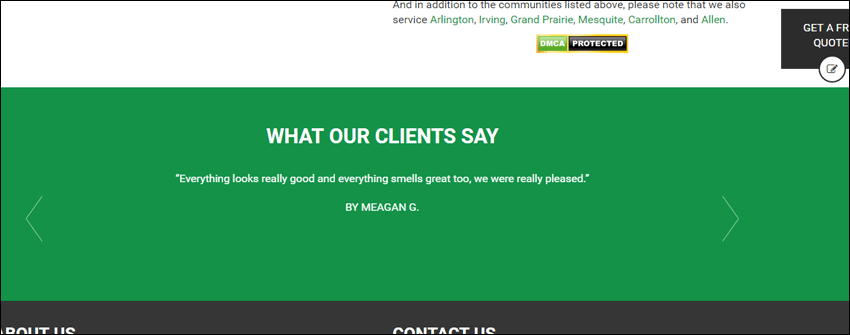
Forget the bland text of the testimonial itself, the total anonymity of the client makes it look like this testimonial is not even real.
While these are current examples (and it’s easy to find countless other examples), persuasive client testimonials have come a long way in the past 20 years. And it’s just as easy to find examples of those as well!
Components of a Credible Testimonial
There are a number of things to consider to improve your testimonials, but let’s start with making them credible. Remember those examples above? There is plenty wrong with them, but the biggest issue by far is the lack of credibility they offer. You have no way of knowing whether or not those people even exist, let alone whether they truly wrote the review.
There are a few critical components to every testimonial on your site if you want it to be believable. These are table stakes in my opinion. If you don’t have each of these, people will start questioning whether the testimonial is real:
Full Name of Reviewer – You absolutely must use your customer’s complete name. Initials just won’t cut it. If the customer won’t let you use their name, find someone else who will. Even if you can name the company (see next item), it’s meaningless if it is a nameless person leaving the testimonial. Testimonials are left by people, not companies.
Job Title & Company – If your company is a B2B business with other businesses as your target customers, then the those who give you testimonials work for those companies, and you must identify those companies, and what the reviewer’s role is there. Neither “John Smith, IBM”, nor “John Smith, HR Director” is nearly as powerful as “John Smith, HR Director, IBM”. Now you’re identifying a real person.
City & State – If your company instead targets consumers, then what company your testimonial-giver works for is probably not relevant. But you still want to identify as specific a person as you can, so include their full city & state. If yours is a local company, it would be even better to give a neighborhood instead of a city. You obviously aren’t going to provide their full address, but you want to be as clear as you can that this is a real person.
Photo – Now we’re getting real. Now we’re showing a real person. Put a photo of the person leaving the testimonial next to the text. A photo of the person makes the testimonial much more credible, as well as more noticeable, which I’ll talk about in a moment.
When I work with clients to improve the testimonials on their site, I often get pushback from them on adding some of this information. They are afraid to divulge too much information about the person who provided the testimonial, fearing privacy issues. They also say it’s difficult to get them to provide a photo.
But to me, the whole point is to make sure that someone could identify the actual person if they wanted. Now they know it’s real.
Look at this testimonial from Anovia Payments, a Merchant Processing company helping businesses accept credit card payments.
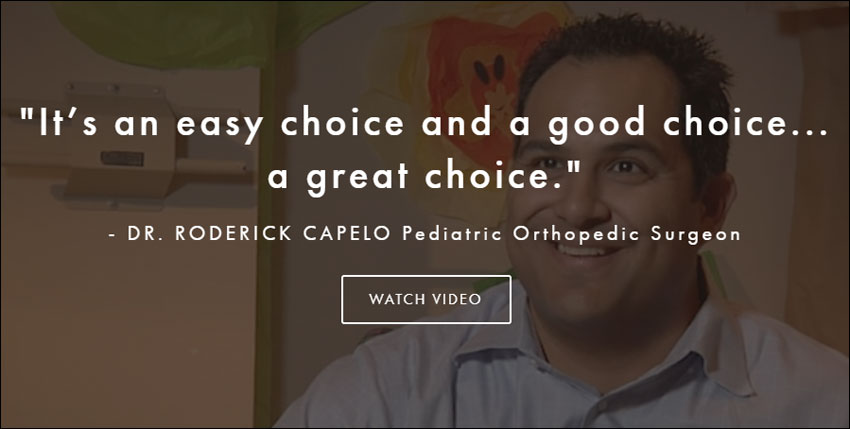
A quick Google search of the information contained in this testimonial shows me it was indeed left by a real person.
The testimonial does not include a company, or in this case a practice name, but for an orthopedic surgeon, that’s probably okay. But there’s still enough information in there that if I wanted, I could quickly verify that Dr. Capelo is real. Just Googling “Dr. Roderick Capelo Pediatric Orthopedic Surgeon”, brings me straight to Dr. Capelo’s bio page at his practice’s site:

A Google search from the info from the testimonial above quickly takes me to this page confirming that it was a real person.
Yep, that’s the guy.
If you’re worried that the people giving you testimonials won’t want you to use their full name, company, etc., then you’re going about it wrong. You absolutely must get their permission to use their testimonial on your site, and they must review and approve it before putting it up. If they aren’t comfortable with using their name or position or company, as I said, just don’t use them and look for someone else.
If you’re having troubles getting them to give you a photo, go look for a photo online yourself. Look at their company website, or their profiles on LinkedIn, Twitter, Facebook, or other social media sites. Find a couple and ask permission to use one with your testimonial.
Now That It’s Credible, Make It Effective
As I said, including the information to make things credible is a table stake. If you can’t do that, you’re wasting your time. But that doesn’t mean that it will automatically sway potential customers to convert. For your testimonials to be truly effective, you want to make sure they’re specific, targeted, and engaging.
Good Testimonials Address Specific Concerns
When potential customers are looking at testimonials, they’re looking for the inside scoop. They’ve already read some of your own marketing-speak on the site touting the great features of your product or service. They know you think it’s great.
They also know that people who have left testimonials think it is great as well. The testimonial adds little value if all it does is say you’re great. Your visitors want to know why you’re great. More importantly, they have some things they’re worried about. Will your solution meet the specific need they have? Hopefully you have good page copy that attempts to alleviate those fears, but a good testimonial that does that will be worth ten times as much.
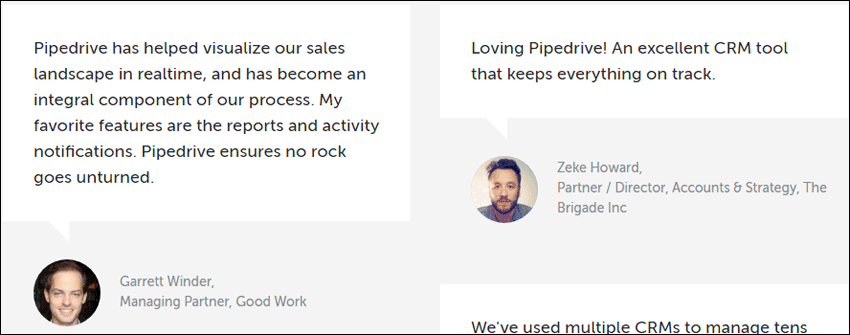
General quotes like, “An excellent tool” and “an integral component of our process” do little to alleviate any specific concerns or questions a visitor probably has about your solution. These testimonials are a wasted opportunity.
Above is a screenshot of a couple testimonials from one of the leading CRM software companies. It’s great that these testimonials are from verifiable providers, but the text used could be so much more effective. People looking into this company have some specific concerns. If they’re looking at a CRM solution for the first time, they may be worried that it will be too hard to use, or that it will take too much time away from their sales team. If they’re considering moving from a different system, they may want to know how this one is better, or if it meets a specific need the other did not. These testimonials don’t provide any of those answers.
Now look at the testimonials from a rival CRM company. These get straight to specific concerns. One addresses that very question of how easy it is to learn and use. One addresses the question of whether sales people can access it from the road instead of having to wait to enter data when they return to the office.
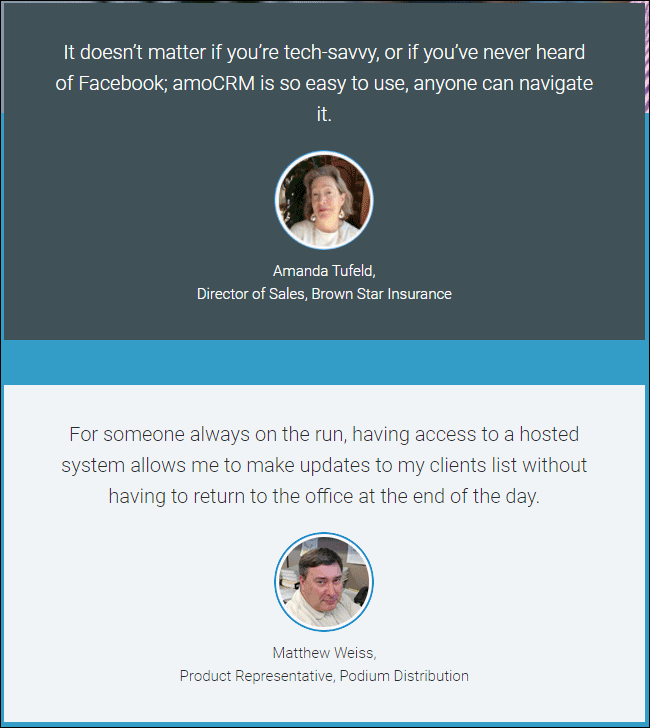
Instead of general “we love you” quotes, this company shows testimonials that answer specific concerns of potential customers, making them much more effective in the conversion process.
These testimonials will go much further toward moving a potential customer toward picking up the phone or filling out a lead form.
Now you obviously can’t write your customer’s testimonial for you (or at least you shouldn’t), but if someone writes a boring testimonial for you, your hands aren’t tied. Just gently respond back to them and ask them to mention a specific problem or concern that they had that you solved. You definitely want your testimonials in your clients’ own words, but that doesn’t mean you can’t give them a little direction and guidance. They’ll be happy that you did.
Use Testimonials from People Who Fit Your Target Market
The whole concept around Social Proof isn’t just that people like to follow the crowd, but that they especially like to follow a crowd that is as much like them as possible. You want to incorporate this as much as possible into the testimonials you choose to display.
The example below is from a provider of Medical Records Software. Now in looking at lots of different websites in this industry, many included good testimonials, but most were provided by doctors. That might make sense at first, since the doctor is the most authoritative position in the medical industry, and the doctor is probably one of the practice owners. But it’s the rest of the staff that is going to use this software themost: the Office Manager, billing people, records, people, etc.
And that’s what this company chose to focus on with their testimonials. The example is from the Office Manager, which is key. That position probably has the biggest stake in the game, and is probably the final decision maker.

For medical practice software, testimonials from Office Managers and Billing Managers will carry a lot more weight with the people evaluating different options than testimonials from doctors.
The person at the practice who is probably tasked with evaluating potential providers is very unlikely to be a doctor. It’s probably the Office Manager, or someone else on the office staff. So when that person is looking at testimonials, he or she will relate much more closely with someone who works on the office staff at a practice, rather than a bunch of doctors. The testimonial will carry more weight.
This website shows four testimonials (regrettably in a carousel, but that’s a different post), and one is from an Office Manager, two are from Billing Managers, and one is from a doctor. That’s a great mix.
Keep Things Brief
Another common characteristic of the “old days” of testimonials was to print these long letters from customers. We thought that repeating the entire email would show just how crazy our customers were about us.
Those days are gone. A bunch of text may work well for a Case Study or a video (see below), but for a testimonial on your landing page, it will just be too long for people to read. Besides, the testimonial is there to help support the main call-to-action, not to take over the user’s focus.
Do your best to keep your testimonials to three of four lines max.
Want Uber-Effective? Use Video Testimonials
Let me repeat, it’s no longer 2002. It’s simple, common, and uber-effective to incorporate persuasive video in your website, and I really can’t think of many better uses of video than your customer testimonials.
By using video as the medium for your testimonials, your site visitors not only get to hear the same message, but they can see the sincerity in your customers’ body language, tone of voice, inflection, smile, and more. Your visitors can also get to know your current customers. They will relate to them. What they say will carry so much more meaning with them.
Here are a couple examples from Xero, a business accounting software provider. These are video testimonials that appear on the Xero home page. Both are less than two minutes long and both do a great job of not only talking about how they like the product, but also of letting you get to know each business owner and being able to relate to them.
Note that the same guidelines to text-based testimonials apply to videos, and these are good examples of that too. Xero clearly targets small business owners and uses entrepreneurs in each case. And both address the advantages of this system over QuickBooks. These testimonials would do well for people who are looking for an alternative to QuickBooks.
Now That You Have Great Testimonials, Make Them Noticeable
While we’re talking about websites from 2002, let’s talk briefly about the Testimonials page you can still find on so many websites. If all of your testimonials are buried on that page, they’re hardly doing anything for you no matter how credible and effective they are.
I can almost guarantee you that your testimonials page is one of the least viewed pages on your site. It’s almost certainly viewed far less than your Home page, and the pages describing your services or products. Those are the pages you want your most relevant and powerful testimonials to be part of.
What are your most landed on pages? For most sites, whether you advertise or not, it’s the Home page. But look at your analytics and see what your top entry pages are. Make sure those pages have testimonials included on them.
Your key decision-point pages are important places for testimonials as well. Often, that little bit of convincing social proof is what your visitor needs to click that button. Placing testimonials near the call-to-action can be especially effective.

This Big Data Analytics provider includes a good customer testimonial right under the Call To Action to start their free trial.
The key here is to sprinkle testimonials throughout the site, so that everyone sees them. If you have an existing testimonials page, it’s not doing you any harm. If you want to leave it in place, that’s fine, so long as the testimonials there are credible & effective.
Graphical Elements Make Your Testimonials Noticeable
We’ve already talked about how including a photo of the person who left the testimonial adds credibility. Another reason to include it is that it makes the testimonial more noticeable. The human brain is wired to notice and look at other faces. So if you have just a quote in a shaded box, some people will see and read it. But if you include the person’s face, more people will look at it.
Company logos also help make the testimonial more noticed. Even if you can’t get a photo of the actual person, a logo for the company will improve your testimonial, both in terms of credibility and in noticeability. Whenever you can, get permission to use the company logo of your customers on your website.
Leverage Praise From Other Sites
Your visitors know that you can really put about anything you want on your website. So if you really want to beef up the credibility, take advantage of what your customers are saying about you on other sites.
Have any of your customers praised you on Twitter? It’s simple to embed real tweets in your site’s content. Your users can click on them and go to the actual tweet on Twitter to see that it’s real.
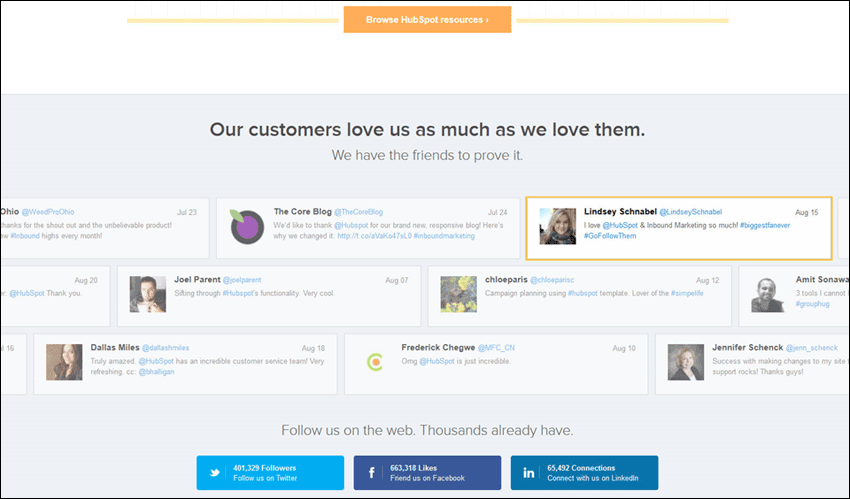
Hubspot uses a scrolling set of verifiable tweets to show how many happy customers they have.
For local businesses, it can often be a chore to request and obtain good testimonials. But so many people are active on Yelp, and many businesses proactively encourage reviews on that site, that you probably have a good number of reviews there that can be featured on your website. And again, it’s simple to embed Yelp reviews on your site. You can do the same thing with Google Reviews if that works better for you.
Update Your Testimonials Now!
Do the testimonials on your site look like they are a decade or two old? Now you are equipped to go and improve them. Make sure they’re all credible by including full names, companies, job titles, photos, and company logos. Make them effective by keeping them brief and choosing the ones that address specific concerns of your prospects. And don’t bury them all on one old-fashioned Testimonials page. Instead sprinkle them throughout your website.
If you’re looking to add new ones, look for people who closely match your targeted customer set. And consider shooting a couple of video testimonials.
I’m interested to hear what tactics have been especially effective for you regarding customer testimonials. Please, tell me in the comments section below!







